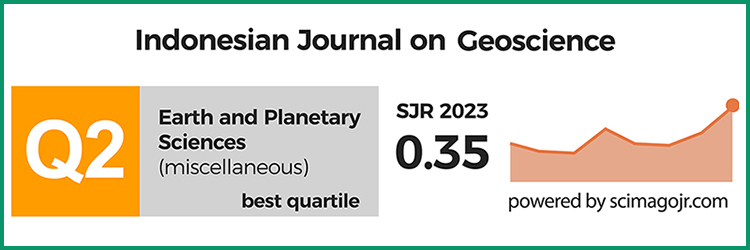Mineralogical and Geochemical Characterization of Jordanian Olivine and Its Ability to Capture CO2 by Mineralization Process
DOI:
https://doi.org/10.17014/ijog.6.2.175-183Keywords:
Olivine, Kharazeh, Jurf Eldaraweesh, CO2, Mineralization processAbstract
DOI:10.17014/ijog.6.2.175-183
Olivine rich rocks outcrop in Kharazeh area (KHO) and Jurf Eldaraweesh (JDO) Basaltic rocks southern Jordan. KHO and JDO have been characterized for their mineralogical and geochemical properties investigated for their potential use in CO2 capture by mineralization process. The effects of particle size, temperature, and contamination time were examined in the mineralization process. Two grain sizes of olivine for each type were used in capture experiments. The first grain size is the separated size fraction between 1 to 0.7 mm (KHO1 and JDO1), while the second grain size is the separated size fraction between 0.7 to 0.3 mm (KHO2 and JDO2). For the mineralization purpose, a chemical reactor was used to determine the olivine CO2 capture capacity. Thin section studies aided by XRD identification for KHO indicated the presence of olivine crystals as the main mineral with percentage reaches 48% plagioclase, augite, and magnetite. While the mineral content for JDO is (35%) olivine, plagioclase, clinopyroxene, and opaque minerals. Olivine chemical composition results show the high MgO percentage for KHO ranges between 47.5 and 50.13%, while the percentage of MgO varies from 43.6% and 44.6% for JDO. The CO2 mineralization process results were interpreted using percentage removal curves. CO2 capture percentage reaches the highest percentage (48%) using KHO2 and 100o C temperature. In summary, it can be concluded that CO2 can be removed from atmosphere using Jordanian olivine rich rocks.
References
Barberi, F, capaldi, g, Casperini, F, Marinelli, G., Santacroce, R., Scandone, R., treuil, M., and varet, J., 1979. Recent basaltic volcanism of Jordan and itsimplications on the geodynamic evolution of the Afro-arabian Rift system. Atti Conv. Lincce, 47, 667-683
Dabirian, R., Beiranvand, M., and Aghahoseini, S., 2012. Mineral carbonation in peridotite rock for CO2 sequestration and a method of leakage reduction of CO2 in the rock. NAFTA 63 (1-2) p.44-48.
Doucet, F., 2011. Scoping Study on CO2 Mineralization Technologies. Report No CGS-2011-007 South African Centre for Carbon Capture and Storage, 88pp.
Dunsmore, H. E., 1992. A Geological Perspective on Global Warming and the Possibility of Carbon Dioxide Removal as Calcium Carbonate Mineral. Energy Convers. Mgmgt., 33, 5-8,565-72. DOI:10.1016/0196-8904(92)90057-4
EPA, 2008. Inventory of U.S. Greenhouse Gas Emissions and sinks: 1990-2006.
ESRL, 2014. Earth System Research Laboratory. ESRL https://www.esrl.noaa.gov/gmd/ccgg/ trends/
Haug, T.A., Johansen, H., and Brandvoll, O., 2010. The way forward for mineral carbonation - importance of collaboration, experiments and modelling. 3rd International Conference on Accelerated Carbonation for Environmental and Materials Engineering, Turku, Finland, p.113-119.
Huijgen, W.J.J. and Comans, R.N.J., 2003. Carbon dioxide sequestration by mineral carbonation: Literature review. ECN report ECN-C-03-016, Energy Research Centre of the Netherlands, 52pp.
Huijgen, W.J.J. and Comans, R.N.J., 2005a. Carbondioxide sequestration by mineral carbonation: Literature review updates 2003-2004. ECN report ECN-C-05-022, Energy Research Centre of the Netherlands, 70pp.
Huijgen, W.J.J., Comans, R.N.J., 2005b. Mineral CO2 sequestration by carbonation of industrial residues: Literature review and selection of residue. ECN report ECN-C-05-074, Energy Research Centre of the Netherlands, 32pp.
IPCC, 2014. Working Group III Fifth Assessment Report ‘Mitigation of Climate Change. https://www.ipcc.ch/report/ar5/wg3/.
Kelemen, P.B. and Matter, J., 2008. In situ carbonation of peridotite for CO2 storage. PNAS, 105 (45), p.17295-17300. DOI:10.1073/pnas.0805794105
King, R.J., 2009. Minerals, Blackwell Publishing Ltd, the Geologists’ Association & The Geological Society of London. Geology Today, 25 (5), p.193-197
Kwon, S., M. Fan, H.F.M. DaCosta, A.G. Russell, 2011. Factors affecting the direct mineralization of CO2 with olivine, Journal of Environmental Sciences, 23 1233-1239. DOI:10.1016/s1001-0742(10)60555-4
Lackner K.S., Wendt C.H., Butt D.P., Edward L., Joyce J., Sharp D.H., 1995. Carbon dioxide disposal in carbonate minerals. Energy 20, 1153-1170. DOI:10.1016/0360-5442(95)00071-n
Lackner K.S., 2002. Carbonate chemistry for sequestering fossil carbon. Annual Review of Energy and TheEnvironment 27, 193-232.
Olivier, J.G.J., Janssens-Maenhout, G., Muntean, M., and Peters, J.A.H.W., 2016. Trends in global CO2 and total greenhouse gas emissions. Report, PBL Netherlands Environmental Assessment Agency, The Hague. PBL publication number: 2315. European Commission, Joint Research Centre (EC-JRC), Ispra. JRC Science for Policy Report: 1034. https://www.pbl.nl/en/publications/trends-inglobal-co2-emissions-2016-report.
Olivier, J.G.J., Schure, K.M., and Peters, J.A.H.W., 2017. Trends in global CO2 and to tal greenhouse gas emissions. Summary of the 2017 Report, PBL Netherlands Environmental Assessment Agency, The Hague. PBL report no. 2983. https://www. pbl.nl/en/ publications/trends-in-global-co2-and-total-greenhousegas-emissions. DOI:10.1787/260645760246
Qianyi, W., 2010. CO2 Sequestration via Olivine Dissolution and Carbonation by Using (HPEC) and (HPIC). B.S., China University of Geoscience, Institute of Geology and Geophysics, Chinese Academy of Sciences.
Schuiling, R.D., 2006b. Mineral sequestration of CO2 and recovery of the heat of reaction.Eds. V.Badescu, R.B.Cathcart and R.D.Schuiling. Springer.
Seifritz, W. 1990. CO2 disposal by means of silicates; Nature 345: 486. DOI:10.1038/345486b0
Sipilä J., Teir S., Zevenhoven R. 2008. Carbon dioxide sequestration by mineral carbonation –Literature review update 2005-2007. Report No 2008-1, Heat Engineering Laboratory, Faculty of Technology, Ǻbo Akademi University, 52pp.
White, C. M., Strazisar, B. R., Granite, E. J., Hoffman, J. S., & Pennline, H. W., 2003. Separation and capture of CO2 from large stationary sources and sequestration in geological formations—coalbeds and deep saline aquifers. Journal of the Air & Waste Management Association, 53(6), 645-715. DOI:10.1080/10473289.2003.10466206
Willson, M.J., 2004. Weathering of the primary rock-forming minerals: processes, products and rates. The Macaulay Institute, UK.



















